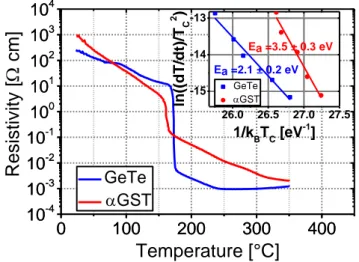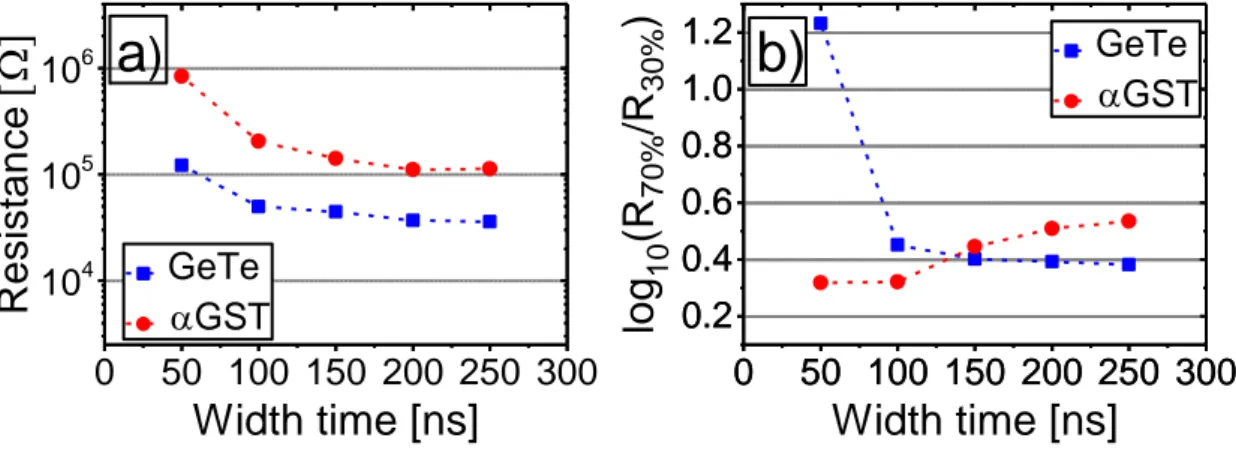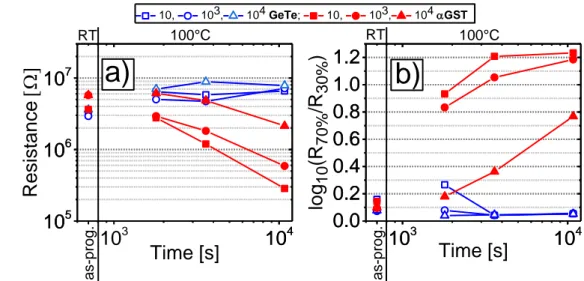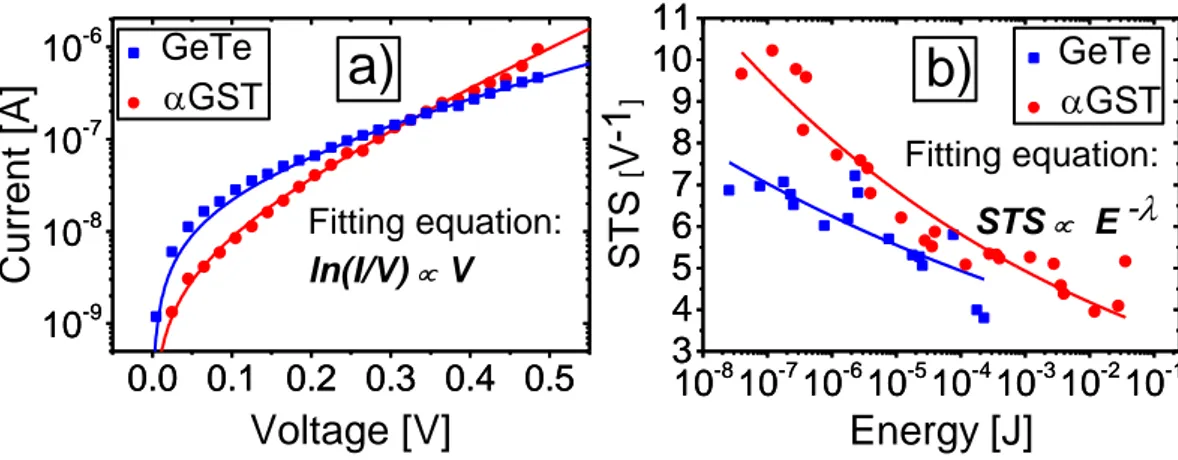HAL Id: cea-03086418
https://hal-cea.archives-ouvertes.fr/cea-03086418
Submitted on 4 Jan 2021
HAL is a multi-disciplinary open access
archive for the deposit and dissemination of
sci-entific research documents, whether they are
pub-lished or not. The documents may come from
teaching and research institutions in France or
abroad, or from public or private research centers.
L’archive ouverte pluridisciplinaire HAL, est
destinée au dépôt et à la diffusion de documents
scientifiques de niveau recherche, publiés ou non,
émanant des établissements d’enseignement et de
recherche français ou étrangers, des laboratoires
publics ou privés.
Reliability analysis in GeTe and GeSbTe based
phase-change memory 4 kb arrays targeting storage
class memory applications
G. Lama, G. Bourgeois, M. Bernard, N. Castellani, J. Sandrini, E. Nolot, J.
Garrione, M.C. Cyrille, Gabriele Navarro, E. Nowak
To cite this version:
G. Lama, G. Bourgeois, M. Bernard, N. Castellani, J. Sandrini, et al.. Reliability analysis in GeTe
and GeSbTe based phase-change memory 4 kb arrays targeting storage class memory applications.
Microelectronics Reliability, Elsevier, 2020, 114, pp.113823. �10.1016/j.microrel.2020.113823�.
�cea-03086418�
Reliability Analysis in GeTe and GeSbTe based Phase-Change Memory
4kb Arrays targeting Storage Class Memory Applications
G. Lama, G. Bourgeois, M. Bernard, N. Castellani, J. Sandrini, E. Nolot, J. Garrione, M. C. Cyrille,
G. Navarro and E. Nowak
CEA, LETI, MINATEC Campus, F-38054 Grenoble, France and Univ. Grenoble Alpes, F-38000 Grenoble, France
Abstract - In this work, we propose a reliability analysis targeting the evaluation of the suitability of a Phase-Change Memory (PCM) device for Storage Class Memory (SCM) applications. Thanks to the analysis of programming and endurance characteristics in single devices and 4kb arrays we compare two different GeTe and GeSbTe (αGST) based PCM. The evolution of the phase-change material along cycling is explained by the analysis of subthreshold characteristics and analytical equations based on experimental data for the description of electrical parameters evolution are given. An extrapolation method to evaluate endurance at more than 109 cycles required for SCM is described and applied, showing the intrinsic high endurance capability and suitability for SCM applications of αGST wrt GeTe.
1. Introduction
Storage Class Memory (SCM) has entered in the hierarchy of the memory systems, with the aim of covering the gap between the main memory (i.e. DRAM), that is fast but volatile and expensive, and the secondary storage, represented by solid state drives (SSD) or hard drive disks (HDD), that features high data capacity and non-volatility but low speed. Therefore, the main requirements for SCM are non-volatility, high density, very low latencies (tens to hundreds of nanoseconds), low cost per bit and physical durability (i.e. high endurance) [1]. Among non-volatile memories, Phase-Change Memory (PCM) is considered the best candidate for SCM applications, because of its competitive switching speed, endurance and scalability [2]. PCM is a dual terminal memory, and it exploits the property of phase-change materials to reversibly switch from an amorphous to a crystalline phase. Such transition is obtained by the Joule heating achieved in the device through the electrical pulse application. The crystalline phase is characterized by a low resistivity and a high reflectivity while the amorphous phase features a high resistivity and a low reflectivity. In 90s, phase-change materials have been used for the fabrication of optical storage devices, such as rewritable DVDs and Blu-Ray disks. Then, since the beginning of 2000s, thanks to the advances in material and device research and engineering, PCM started to be considered as a reliable competitor for next generation of non-volatile memory. Today, PCM’s high maturity is demonstrated by its commercialization in SCM market [3], thanks to 3D XPoint technology [4], and by the
recent demonstration of its manufacturability and reliability in 28 nm technology node for automotive applications [5].
Material and stoichiometry engineering in PCM is considered the main factor for boosting the device performances [6]. Materials along the GeTe-Sb2Te3 tie line, such as GeTe [7] or GeSb2Te4 [8], were identified for their high programming speed and they represent possible candidates for SCM applications. However, in order to address SCM, low programming variability at array level and stability of the phase-change material along endurance are fundamental to ensure the reliability in high density memory arrays. In this work, we compare GeTe and αGeSbTe (αGST) based PCM performances to target the specifications of SCM applications. We focus on programming speed showing how the variability within 4kb matrices is correlated to the material properties and the pulse shape. Moreover, data retention tests are performed on fresh and cycled devices, highlighting the material properties evolution triggered during the programming cycles. Finally, we investigate how the pulse energy affects the amorphous subthreshold characteristics of the PCM and the device endurance. Our analysis leads to demonstrate best endurance performances up to 109 cycles and suitability for SCM of αGST with respect to GeTe,
2. GeTe and αGST Analysis Targeting SCM
GeTe and αGeSbTe (αGST) compositions developed and analyzed are highlighted in the Ge-Sb-Te ternary diagram of
Fig. 2. Resistivity of as-deposited amorphous GeTe and αGST as
a function of the temperature. Inset: Kissinger plot for Activation Energy of crystallization (Ea is the slope of the Kissinger plot)
extraction.
0
100
200
300
400
10
-410
-310
-210
-110
010
110
210
310
40
100
200
300
400
10
-410
-310
-210
-110
010
110
210
310
4 26.0 26.5 27.0 27.5 -15 -14 -13Res
is
tiv
ity
[
c
m
]
GeTe
GST
Temperature [°C]
Ea =3.5 ± 0.3 eV ln ((dT /d t)/T C 2 ) 1/kBTC [eV-1] GeTe GST Ea =2.1 ± 0.2 eV 0 25 50 75 1000 25 50 75 100 0 25 50 75 100GeTe
Ge2Sb2Te5GST
Sb
(
%
)
T
e
(%)
Ge (%)
Sb2Te3Fig. 1. Ge-Sb-Te ternary diagram highlighting the PCM materials analyzed in this work: GeTe and αGST. A simplified scheme of our “Wall” based PCM device is reported on the right; devices with 100 nm heater width are considered in this work.
Fig. 1. Resistivity of as-deposited amorphous full-sheet layers as a function of temperature (R-vs-T), reported in Fig. 2, was measured by four-probe technique heating the sample at a rate of 17°C/min. The inset of Fig. 2 shows the activation energy of crystallization calculated by Kissinger method in both materials. The drop in resistivity after 150°C corresponds to the transition from the amorphous to the crystalline state. The crystallization temperature of GeTe is higher wrt αGST, however the
crystallization dynamic is different in the two layers as the activation energy of the crystallization is higher in αGST. Indeed, the two materials show different crystallization mechanisms. The crystallization involves nuclei formation in the amorphous matrix and successive nuclei growth. A material is growth-dominated if the crystallization happens thanks to the fast growth of few crystal nuclei, leading to a steep amorphous to crystalline transition in the R-vs-T plot as observed in GeTe [7]. On the other hand, a material is nucleation-dominated if a larger number of nuclei are formed, leading to a low growth rate. This is the case of αGST, which exhibits a nucleation-dominated crystallization [9], also highlighted by a more gradual reduction of the resistivity (i.e. grain growth) in the R-vs-T plot. However, the resistivity evolution of GeTe must be analyzed also in the light of a faster aging of GeTe layer after air exposure wrt αGST which could represent a problem in process integration steps, in particular in highly scaled PCM devices [10].
GeTe and αGST were integrated in state-of-the-art “Wall” PCM devices into the Back End of Line (BEOL) of the fabrication of LETI Memory Advanced Demonstrator (MAD) based on 130 nm CMOS technology. To accomplish statistical analysis, the measurements were performed in 4kb arrays consisting of 1-Transistor-1-Resistor (1T1R) devices with a heater width of 100 nm (see Fig. 1 on the right for the device simplified scheme).
RESET (high resistance state) and SET (low resistance state) preliminary distributions in 4kb arrays are achieved with optimized current pulses (Fig. 3). SET operation in this case is Fig. 3. Cumulative distributions of RESET and SET resistances for
GeTe and αGST 4kb PCM arrays. On the right, the median and the standard deviation of the distributions are summarized, obtained with optimized RESET and SET pulses.
10
310
410
510
610
70
20
40
60
80
100
10
310
410
510
610
70
20
40
60
80
100
10
410
510
6CD
F [
%]
GeTe
GST
SET
RESET
Resistance
[
]
RESET
SET
GSTRe
s
is
tance
[
]
GeTeFig. 4. SET programming speed tests performed in 4kb PCM arrays with constant pulse fall time (10 ns) and increasing pulse width: evolution of the median of the resistance values (a) and of the resistance spread (b) are reported.
0
50 100 150 200 250 300
10
410
510
60
50 100 150 200 250 300
0.2
0.4
0.6
0.8
1.0
1.2
0
50 100 150 200 250 300
0.2
0.4
0.6
0.8
1.0
1.2
Width time [ns]
GeTe
GST
a
)
Re
sista
n
ce
GeTe
GST
log
10(R
70%/R
30%)
Width time [ns]
b)
Fig. 5. SET programming speed tests performed in 4kb PCM arrays with constant pulse width (300 ns) and increasing pulse fall time: evolution of the median of the resistance values (a) and of the resistance spread (b) are reported.
10
010
110
210
310
410
510
610
410
510
010
110
210
310
410
510
60.10
0.15
0.20
0.25
0.30
0.35
0.40
0.45
GeTe
GST
R
es
is
tan
c
e
Fall time [ns]
a
)
lo
g
10(R
70%/R
30%)
Fall time [ns]
GeTe
GST
b)
performed with a single long pulse (width time of 300 ns and fall time of 100 μs) in order to reach the minimum resistance value achievable in the devices under investigation. Only single pulse programming approach was considered in our tests, without any program-verify strategy. The high resistance window of about two orders of magnitude is verified for both materials. However, the GeTe SET state shows a higher variability wrt αGST.
2.1 Speed analysis
We evaluated the programming speed in 4kb arrays analyzing the SET speed, since SET operation (involving the material crystallization) is known to be slower wrt RESET operation in PCM. SET pulses with incremental width and optimized current amplitude were applied, before each SET pulse the devices were programmed into the RESET state (Fig. 4a). GeTe shows capability of 50 ns SET time, despite a high variability within the 4kb array mainly due to a part of the population remaining in the RESET state. In αGST, SET operation can be obtained only with pulses higher than 100 ns. However, low resistance variability is obtained for 100 ns pulse
duration in both materials. (Fig. 4b). Nevertheless, it should be noticed that the maximum speed achieved is limited by the measurement setup used for arrays, indeed a switching speed of 1 ns was already demonstrated for SET and RESET in GeTe single devices [7]. Therefore, our speed results should be considered for statistical material comparison more than minimum absolute SET pulse duration. The benefit of the pulse fall time increase is more evident in αGST where a constant decrease of the SET resistance is achieved down to less than 10kΩ (Fig. 5a). Moreover, αGST shows the capability of an even more reliable SET state wrt GeTe thanks to pulse fall time increasing, demonstrated by the considerable reduction of resistances variability (Fig. 5b). We think that it could be related to the different crystalline nature of the two materials. αGST has different crystalline phases and morphologies, and the degree of crystallinity can be easily tuned with a consequent large resistivity variation, whereas GeTe presents a single amorphous to crystalline phase transition. Moreover, the higher vacancies density in the crystalline lattice of cubic αGST favors a higher crystal reorganization wrt GeTe [11][12].
2.2 Data retention analysis
We performed retention tests on RESET state to compare the amorphous phase stability in both materials. We annealed at 100°C the 4kb arrays programmed in the RESET state after different number of cycles up to 104 cycles(Fig. 6). GeTe shows a higher stability wrt αGST even after 104 cycles, according to previous results reported about GeTe compared to standard Ge2Sb2Te5 [13]. Nevertheless, αGST shows an interesting retention improvement after cycling, together with a reduced variability. This improvement of data retention could be attributed to an evolution of the material along cycling. As previously reported for standard Ge2Sb2Te5 [14], the material could undergo a stoichiometry evolution in the active volume due to a progressive increase of Sb concentration [15], leading to a higher immunity to recrystallization of the correspondent amorphous phase [16]. The higher nucleation rate even at 100°C in αGST leads to the higher probability of the appearance of nuclei wrt GeTe, with the consequent decrease of the RESET resistance.
Fig. 6. RESET state retention at 100°C for GeTe (empty symbols) and αGST (filled symbols). RESET resistance in 4kb arrays, median (a) and variability (b), are reported after programming (as-prog.) at room temperature (RT), their evolution in time post an 100°C anneal performed after 10 cycles, 103 cycles (in 1000 devices) and 104cycles (in 100 devices) is reported.
10
4 as-p rog .10
310
510
610
710
410
510
610
710
310
4 as-p rog .0.0
0.2
0.4
0.6
0.8
1.0
1.2
10
310
40.0
0.2
0.4
0.6
0.8
1.0
1.2
10, 103, 104 GeTe; 10, 103, 104 GSTResistance
Time [s]
a)
b)
log
10
(R
70%
/R
30%
)
Time [s]
100°C RT 100°C RTFig. 7. Endurance performed on GeTe and αGST with long RESET and SET pulses (~10 µs). Evolution of SET and RESET resistances are reported as a function of cumulative pulses energy (E) in 70 devices. Median, 16th and the 84th percentile (that correspond to one standard deviation σ) of resistances have been represented.
10-8 10-7 10-6 10-5 10-4 10-3 10-2 103 104 105 106 107 10-8 10-7 10-6 10-5 10-4 10-3 10-2 103 104 105 106 107 105 cycles SET GeTe RESET GeTe SET GST RESET GST 104 cycles Re s is tance [ ] Energy [J]
2.3 Endurance
To compare the impact of cycling in GeTe and αGST, we accelerated the degradations phenomena applying a sequence of long SET and RESET pulses (i.e. width time 10 µs). In Fig. 7 the RESET and SET resistance states evolution are reported for both materials as a function of the cumulative energy applied on the devices along cycling (E). GeTe, despite a stable resistance window, shows a fast degradation of both programming states after about 0.3 mJ (i.e. 104 cycles). On the contrary, αGST preserves a reliable programming even after more than 1 mJ (i.e. more than 105 cycles). In order to understand the material evolution ongoing, we analyzed the change of the subthreshold conductivity of the amorphous phase along cycling for both materials. In the subthreshold regime, the electrical transport in our materials is well described by a Poole conduction (ln(I/V) ∝ V) [17], which is linked to the presence of a high trap sites density (i.e. short trap-to-trap distance Δz), as can be seen in Fig. 8a. The subthreshold slope evolution (defined as
STS = dln(I)/dV in the subthreshold regime) is correlated with
the trap density in the following way [18]: 𝑆𝑇𝑆 = 𝑘 ∆𝑧
2 𝑢𝑎 (1)
where k is a constant and 𝑢𝑎 is the amorphous thickness. The
STS calculated for both materials along cycling is reported as a
function of E in Fig. 8b. We observe a decrease of STS in both materials with a similar power law trend:
𝑆𝑇𝑆 ∝ 𝐸−𝜆 (2)
A higher STS in αGST is an evidence of a lower density of defect sites wrt GeTe [19]. Moreover, the decrease of STS along cycling confirms a material evolution that is not necessarily a precursor of endurance degradation. This is supported by the fact that αGST shows perfect SET and RESET operations even after reaching same STS values at which GeTe shows programming failure. This evolution is driven by the high temperature gradient achieved in the device during the programming, which can contribute to the stoichiometry change and atomic displacement in the active volume of the cell. These results confirm what is already observed in retention measurements. However, while a Sb enrichment is not detrimental for the switching properties of the device, as certified by record endurance of 1012 cycles achieved in segregated Sb-rich alloys [20], a slight segregation or stoichiometry evolution in GeTe could lead to the degradation of its switching properties [21].
Finally, PCM endurance capability was evaluated performing several endurance tests using different sets of RESET+SET pulses with increasing total energy ESR (Fig. 9), in order to take
advantage of the power law correlation between the number of cycles (Ncycles) and the pulse energy [22]:
𝑁𝑐𝑦𝑐𝑙𝑒𝑠∝ 𝐸𝑆𝑅−𝐶 (3)
with C a material dependent coefficient. Ncycles is the number of
cycles obtained before the failure conditions, which take into account both a reduction of the resistance window and a reduction of the RESET resistance. This relationship indicates that the lifetime of the device depends on the energy (i.e. duration) of the single programming pulse. Indeed, longer pulses could involve phenomena such as materials inter-diffusion or electro-migration, accelerated in a stationary regime that submits the device to a high temperature gradient and localized high electric field.
In our endurance test the pulse energy was modified through the variation of the width time of SET and RESET pulses. Considering a minimum energy of 0.1 nJ for single reliable SET+RESET operation (compatible with our previous speed tests), we extrapolated the total number of cycles achievable. We can observe a higher endurance capability in αGST wrt GeTe, Fig. 8. a) Subthreshold characteristics of RESET devices before cycling. b) STS evolution as a function of the cumulative pulse energy along cycling (E), described by a power law (λ coefficient is material dependent).
0.0 0.1 0.2 0.3 0.4 0.5
10
-910
-810
-710
-60.0 0.1 0.2 0.3 0.4 0.5
10
-910
-810
-710
-610
-810
-710
-610
-510
-410
-310
-210
-13
4
5
6
7
8
9
10
11
10
-810
-710
-610
-510
-410
-310
-210
-13
4
5
6
7
8
9
10
11
GeTe
GST
Voltage [V]
Fitting equation:
ln(I/V)
V
a)
C
urrent
[
A]
b)
GeTe
GST
ST
S
[V
-1
]Fitting equation:
STS
E
-
Energy [J]
Fig. 9. Cycles number achieved for different SET+RESET pulses energy ESR (i.e. increasing SET+RESET pulse duration) and
extrapolation at 0.1 pJ. Each test was performed on a population of 70 devices. Median, 16th and the 84th percentile (that correspond to one standard deviation σ) of number of cycles are represented.
0.1
1
10
100
10
210
310
410
510
610
710
810
90.1
1
10
100
10
210
310
410
510
610
710
810
90.1
1
10
100
10
210
310
410
510
610
710
810
9 GeTe GST Failure conditions: 1)RRESET/RSET< 5 2)RRESET< 70% RRESET,init Ncycles ESR-CCyc
les
ESR [nJ]
reaching about 109 cycles for the device size considered. This result can be attributed to the lower density change during phase transition in GeSbTe materials wrt GeTe [23], which could delay the material degradation and void formations.
3. Conclusions
We analyzed programming reliability of GeTe and αGST based 4kb PCM arrays targeting SCM. High programming speed is ensured in both materials, showing the possibility of a lower SET variability in αGST by pulse fall time control. We provided evidences of the materials evolution during programming operations, thanks to retention and subthreshold conduction measurements along cycling, pointing out how such evolution is more detrimental for GeTe than for αGST. Endurance tests highlighted the dependency of the total cycles number on the single pulse duration. Finally, thanks to this correlation, endurance up to more than 109 cycles is extrapolated for αGST, proving its suitability for SCM applications.
Acknowledgements
This work has been partially supported by the European 783176 WAKeMeUP Project, financed by European commission, French government and Auvergne-Rhône Alpes Region.
References
[1] R. F. Freitas and W. W. Wilcke, "Storage-class memory: The next storage system technology", IBM Journal of Research and Development. Vol. 52, no. 4.5, pp. 439-447, July 2008.
[2] S. W. Fong et al., "Phase-Change Memory—Towards a Storage-Class Memory", IEEE Transactions on Electron Devices, Vol. 64, no. 11, pp. 4374-4385, Nov. 2017. [3] H.-Y. Cheng et al., " 3D cross-point phase-change memory
for storage-class memory", J. Phys. D: Appl. Phys. 52 473002, 2019.
[4] https://www.intel.com/content/www/us/en/architecture-and-technology/intel-optane-technology.html
[5] P. Cappelletti et al., "Phase change memory for automotive grade embedded NVM applications", J. Phys. D: Appl. Phys. 53 193002, 2020.
[6] G. Navarro et al., "Phase-Change Memory: Performance, Roles and Challenges", 2018 IEEE International Memory Workshop (IMW), pp. 1-4.
[7] G. Bruns et al., "Nanosecond Switching in GeTe Phase Change Memory Cells", Appl. Phys. Lett. 95, 043108, 2009.
[8] Nishant Saxena et al., "Sub-nanosecond threshold switching dynamics in GeSb2Te4 phase change memory device", J. Phys. D: Appl. Phys. 53 025103, 2019.
[9] G.F. Zhou et al.,"Crystallization behavior of phase change materials: comparison between nucleation- and growth-dominated crystallization", 2000 Optical Data Storage. Conference Digest, pp. 74-76.
[10] A.N.D. Kolb et al., "Understanding the Crystallization Behavior of Surface-Oxidized GeTe Thin Films for Phase-Change Memory Application", ACS Appl. Electron. Mater., 1, 5, pp. 701-710, 2019.
[11] V. Bragaglia et al., "Metal - Insulator Transition Driven by Vacancy Ordering in GeSbTe Phase Change Materials", Sci Rep 6, 23843, 2016.
[12] T. Siegrist et al., "Disorder-induced localization in crystalline phase-change materials", Nature Mater 10, pp. 202–208, 2011.
[13] L. Perniola et al., "Electrical Behavior of Phase-Change Memory Cells Based on GeTe", IEEE Electron Device Letters, vol. 31, no. 5, pp. 488-490, May 2010.
[14] J. Sarkar et al., "Evolution of phase change memory characteristics with operating cycles: Electrical characterization and physical modeling", Appl. Phys. Lett. 91, 233506, 2007.
[15] J. Park et al., "Phase-Change Behavior of Stoichiometric Ge2Sb2Te5 in Phase-Change Random Access Memory", Journal of The Electrochemical Society, 154 (3) H139-H141, 2007.
[16] S. O. Ryu et al., "Crystallization Behavior and Physical Properties of Sb-Excess Ge2Sb2+xTe5 Thin Films for Phase Change Memory (PCM) Devices", Journal of The Electrochemical Society, 153 (3) G234-G237, 2006. [17] M. Le Gallo et al., "Subthreshold electrical transport in
amorphous phase-change materials", New J. Phys., vol. 17, no. 9, 2015.
[18] D. Ielmini and Y. Zhang, "Analytical model for subthreshold conduction and threshold switching in chalcogenide-based memory devices", J. Appl. Phys., vol. 102, no. 5, 054517, Sep. 2007.
[19] J. Luckas et al., "Defects in amorphous phase-change materials", Journal of Materials Research, 28(9), pp. 1139-1147, 2013.
[20] W. Kim et al., "ALD-based Confined PCM with a Metallic Liner toward Unlimited Endurance", 2016 IEEE International Electron Devices Meeting (IEDM), pp. 4.2.1-4.2.4.
[21] S. Raoux et al., "Crystallization times of Ge–Te phase change materials as a function of composition", Appl. Phys. Lett. 95, 071910, 2009.
[22] S. Lai, "Current status of the phase change memory and its future", 2003 IEEE International Electron Devices Meeting, pp. 10.1.1-10.1.4.
[23] T. Nonaka et al., "Crystal structure of GeTe and Ge2Sb2Te5 meta-stable phase", Thin Solid Films 370, pp. 258-261, 2000.



